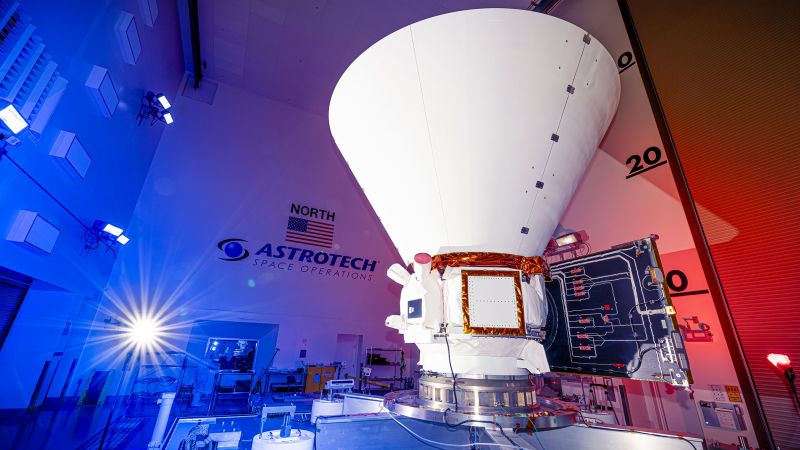NASA is gearing up for an exciting dual launch that promises to expand our understanding of the cosmos. This two-for-one mission will see the launch of the SPHEREx telescope, aimed at uncovering the fundamental ingredients for life within the Milky Way galaxy, alongside a mission known as PUNCH, which is focused on solar observations. The launch is scheduled to take place on Monday at 11:10 p.m. ET (8:10 PT) from Vandenberg Space Force Base in California aboard a SpaceX Falcon 9 rocket. NASA plans to provide live coverage of this significant event, starting at 10:15 p.m. ET through its NASA+ platform and YouTube channel.
Residents of nearby counties, including Santa Barbara, San Luis Obispo, and Ventura in California, may experience sonic booms from the launch, weather permitting, as stated by SpaceX officials. Should the launch face delays, there are alternative launch windows available all the way through April, providing some flexibility for the ambitious plans.
Originally, the launch window opened on February 28. However, several integration challenges arose during the attachment of the missions to the rocket, as well as issues related to encapsulating the two missions in a protective faring. Julianna Scheiman, director of NASA’s Science Missions at SpaceX, noted that a recent launch attempt on Saturday night had to be scrubbed to allow teams to continue the necessary rocket checkouts in preparation for liftoff.
Despite their different scientific objectives, the decision to launch PUNCH simultaneously with SPHEREx effectively serves to maximize scientific output for a lower cost, as highlighted by Dr. Nicky Fox, associate administrator for NASA’s Science Mission Directorate. Both missions are designed to enter a sun-synchronous orbit around the poles of Earth, keeping each spacecraft consistently oriented with respect to the sun throughout the year.
SPHEREx, or the Spectro-Photometer for the History of the Universe, Epoch of Reionization and Ices Explorer, aims to explore the evolution of the universe and to seek out the origins of life’s essential building blocks in the cosmic expanse. Meanwhile, PUNCH, which stands for Polarimeter to Unify the Corona and Heliosphere, will focus on examining the sun’s influence on the solar system, particularly observing the corona—the sun’s outer atmosphere—and studying solar wind dynamics.
The two missions present an array of exciting opportunities to uncover unknown aspects of our solar system and galaxy. Dr. Mark Clampin, acting deputy associate administrator of NASA’s Science Mission Directorate, noted, “These missions cover the full breadth of the science that NASA does every day.” He further explained the complementarity of the missions; while PUNCH aims to conduct an in-depth study of the sun, SPHEREx will embark on a survey mission that scans the night sky for hundreds of millions of stars.
Once operational, SPHEREx will orbit the Earth at an altitude of 404 miles (650 kilometers) for just over two years, during which it will collect extensive data on more than 450 million galaxies and survey over 100 million stars within our galaxy. This ambitious effort to map the distribution of galaxies will assist scientists in decoding the cosmic phenomenon of inflation, which sparked the universe’s rapid expansion shortly after the Big Bang.
A notable feature of SPHEREx is its capacity to survey the sky in 102 different wavelengths of infrared light—an essential tool for studying celestial bodies. This capability will allow scientists to glean valuable insights into the chemical makeup of these cosmic objects by isolating their chemical compounds. Jamie Bock, the principal investigator for SPHEREx, emphasized the pioneering nature of this mission, asserting that it marks the first effort to examine the entire sky in an extensive array of infrared colors, thereby opening doors to future discoveries.
One of the core objectives for SPHEREx is to identify extraterrestrial water, carbon dioxide, and other life precursors present in the gas and dust clouds that serve as stellar nurseries. These areas, believed to host new stars with surrounding material disks, are crucial because it is assumed that the majority of the universe’s water can be found encased in ice within these dust grains—potentially offering clues about the water that formed Earth’s oceans.
Complementing SPHEREx, the PUNCH mission consists of a constellation of four small spacecraft that will remain in orbit around our planet for the next two years, gathering insights into the sun and its heliosphere—the expansive magnetic bubble formed by solar particles. Each satellite is equipped with specialized cameras, serving a dual purpose of functioning as a synchronized unit to photograph the sun’s corona and to map solar features essential for understanding solar dynamics.
As solar phenomena, including solar winds and storms, significantly influence space weather and have effects on Earth, the data obtained from PUNCH will enhance our understanding of these processes, potentially leading to improved predictions about how solar activity may impact terrestrial technology and atmosphere.
The successful interplay between these missions, along with other NASA projects like the Parker Solar Probe












